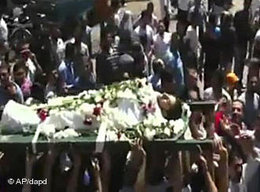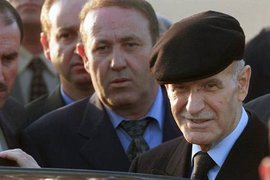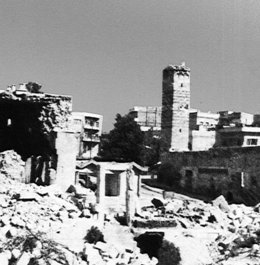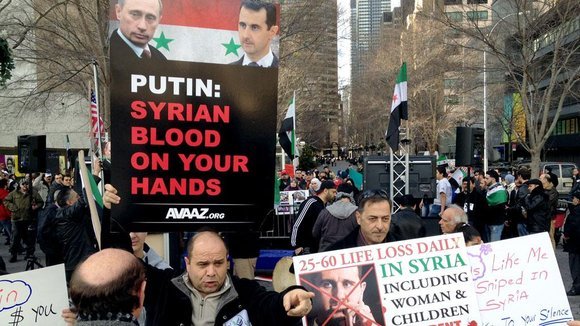Homs and Hama: Is History Repeating Itself?
It is lunchtime on Friday, 3 February 2012. Thousands of people are demonstrating against the Assad regime in Homs. "Forgive us, Hama," they chant in remembrance of the massacre that took place in the Syrian city of Hama 30 years ago. They have no idea that they themselves will be the victims of a massacre only a few hours later.
That evening, the Syrian Army launches its attack on the city of Homs. Residential areas of the city are pounded with shells; more than 300 people have already been killed. Hundreds of seriously injured people have to endure appalling suffering because the makeshift clinics lack medical material. The images from Homs are so dreadful that they are not shown on Western television.
Anas, a 45-year-old Syrian man, sees the videos of dying children and bodies that have been ripped apart in explosions on the Internet. He is sitting in front of a computer in a small German city. The expression on his face is stony. The images bring back memories of what happened in his home town of Hama in February 1982.

Back then, government troops stormed the city and went on the rampage there for three weeks. By the time they were finished, 20,000 people lay dead, according to conservative estimates of human rights organisations. The massacre in Hama is one of the worst crimes committed in the Middle East in the twentieth century, despite the fact that it has hardly been investigated and publically addressed so far.
Anas is not his real name. He wants to remain anonymous in order to avoid putting his family in Syria at risk. To this day, his father still lives in Hama; his brothers and a few cousins live in the suburbs of Damascus. Anas has already spent more than half of his life in Germany. He is a manager in the automotive industry; a slender man with metal-rimmed glasses that give him an intellectual air.
When his relations tell him via Skype about the tanks, mass arrests, snipers, and corpses on the streets, Anas is forced to think of what happened back in Hama. He points out that back in 1982, there was one huge massacre; today, on the other hand, there are lots of smaller massacres in various different places. And yet there is another significant difference between the two: the history leading up to the massacres.
The rise of the Alawites
The 1970s was a decade of social tension in Syria. When the Socialist Baath Party seized power in 1963, the influence of the urban elites began to wane, while the poor rural population was given targeted support.
In 1970, the then Minister for Defence, Hafez al-Assad, came to power in a bloodless coup. It was the first time that someone from the lowest class in Syrian society had assumed power in the country. Assad hailed from the traditionally disadvantaged Alawite minority and chose the only path to political power that was open to him: a career in the military.
He used the Baath ideology – a mixture of socialism and Arab nationalism – to turn Syria into a self-confident nation. At domestic level, however, the Baath Party soon began betraying its own ideals. Throughout the 1970s, a network of corruption and nepotism emerged; representatives of the regime began to brazenly line their own pockets.

Resentment grew, particularly among those members of society who were losing out. The urban middle class lost political influence; long-standing merchants struggled against nouveau-riche upstarts; religious authorities began to slide into insignificance in the face of the prevailing secular climate.
This frustration became the breeding ground for an Islamic opposition. The party of the Muslim Brotherhood became the voice of conservative Sunnis and gained support, above all in Aleppo and Hama. President Assad succeeded in limiting the influence of the Muslim Brotherhood in Damascus by forging economic ties with important circles of Sunni society, thereby binding them to himself. This close bond exists to this day, which is why the business elite in the capital is not openly opposing the regime even in the current crisis.
As a young boy, Anas witnessed the rise of the Muslim Brotherhood. He also saw how economic dependencies led to denominational hate in Hama. "The people living in the countryside around Hama were Alawites who had served the urban Sunnis," he recalls. "They haven't forgiven them for that to this day."
The conflict with the Muslim Brotherhood
The rise of the Alawites began with Assad's takeover of power. Many left their native home in the mountainous regions near the Mediterranean coast – where for centuries, they had sought shelter from persecution – and moved into the cities. There, they found jobs in public administrations, secret services, and in the military. To this day, there is a disproportionally high number of Alawites in the state security forces.
This new power constellation allowed victims to turn into perpetrators. According to Anas, Alawite members of the secret service were driven by inferiority complexes and feelings of revenge whenever they managed to get their hands on Islamists, most of whom were well educated. His cousin was imprisoned in 1979. To this day, he says, a chill runs down his spine whenever he thinks of his cousin's scarred back and torn out finger nails.

Several of Anas' older cousins joined the Tali'a al-Muqatila, the "Fighting Vanguard" of the Muslim Brotherhood. The radical Islamists challenged the secular Baath regime with targeted attacks on government representatives and bomb attacks on public buildings and military institutions.
President Assad's reprisal was brutal. Immediately after a failed assassination attempt in June 1980, Assad passed a decree making membership of the Muslim Brotherhood a capital offence. It was a licence to kill that has never since been revoked. Hundreds of incarcerated members of the Muslim Brotherhood were massacred in their prison cells. In Aleppo and Hama, men and boys over the age of 14 were arbitrarily rounded up and summarily shot.
The situation was escalating into an open war. This war began in the early hours of 2 February 1982 when an army unit attacked Muslim Brotherhood hideouts in the old quarter of Hama. Hundreds of fighters initially forced the soldiers to make a retreat, stormed the government building, killed leading members of the party, and declared Hama liberated on the morning of 2 February. It was a shock for the regime in Damascus, which began to prepare itself for the decisive battle against the Islamists. For Assad, it was no longer a question of defeating them, but annihilating them.
The nightmare of Hama
What followed was a three-week nightmare. The Syrian human rights committee, a non-governmental organisation that has been officially banned, documented the massacre of Hama, district by district, with the help of eye-witness reports. This shocking report contains details that are humanly inconceivable in their atrocity. Entire families were murdered in their homes; men were put to death by firing squad on the street; women and children who hid in shops or mosques were shot dead; old Muslim sheikhs were tortured; entire streets and residential areas were bombarded.
The eye-witness reports are in line with the stories Anas heard from his relatives. Anas himself succeeded in fleeing Hama right at the beginning of the massacre; he is the only man of fighting age in his family who managed to get out of the city alive.
His cousins and aunts who remained in Hama and survived the ordeal were completely traumatised, he explains. "One of my cousins hid with her mother and about 60 other people in a basement," he says. Soldiers stormed into the room and shot everyone there. His cousin, a young girl, and her neighbour's infant baby were the only ones to survive. "If anyone moved, the soldiers opened fire again," says Anas, "then they stole watches and jewellery and left." His cousin only survived because her mother fell on top of her.
By the end of February 1982, most of Hama had been reduced to rubble; mosques and churches had been systematically destroyed; the historical old quarter of the city, a UNESCO world heritage site, was lost forever. About 20,000 people had been killed; tens of thousands had been arrested or went missing; many of them never returned.
A national trauma
Hama became a trauma for an entire nation. And a taboo subject. The city itself was rebuilt very quickly, and all traces removed. A veil of silence – a collective silence – descended over the social scars.
The regime held the Muslim Brotherhood responsible for the violence (and still does to this day) and practically wiped its party off the face of the earth: active members were killed, supporters arrested, and those who escaped the persecution, fled abroad, where various movements were shaped by political leaders in exile.

Then as now, the Syrian Muslim Brotherhood does not create the impression of being united. Its leader, Mohammed Riad al-Shaqfa, lives in Turkey, where the Syrian opposition abroad has been forming for months.
The Muslim Brotherhood is the largest grouping in the Syrian national council, the most important opposition alliance outside Syria. For some, they already have too much influence. Above all others, it is Syria's minorities – the Christians, the Alawites, the Druze and others – who fear the Sunni majority's Islamic agenda in the event of regime change. Secretary-General Mohammed Riad al-Shaqfa tries to dispel these fears by making statements like "Sharia cannot be imposed on anyone by force" and "We, as the Muslim Brotherhood, will defend the rights of minorities."
Anas remains sceptical. He feels that the Muslim Brotherhood has not addressed its own past in Syria honestly and critically. Shaqfa, who has lived abroad since the 1970s, distances himself from the terror back then and claims that the attacks were carried out by independent cells that didn't even officially belong to the Muslim Brotherhood. In Anas' eyes, this is an attempt to shirk responsibility.
Like father, like son
But the Muslim Brotherhood has other worries at the moment; after all, they are also being made responsible for the violence in the current crisis. Thirty years after Hama, President Bashar al-Assad is employing the same rhetoric as his father and playing up the "Islamist threat" facing the country: terrorist groups want to destroy Syria from outside the country, he claims. However, unlike the situation in the early 1980s, today's propaganda has nothing to do with reality.
It is not armed terrorists, but peaceful demonstrators – who are now being supported by army deserters – who have been challenging the Assad regime for almost a year now. Then, a radical Sunni minority wanted an Islamic state; today, Syrians of all religions and social classes are demanding freedom and democracy. In short: 30 years ago, an Islamic party was fighting a secular regime; today, the people are liberating themselves from a dictatorship.
Images of protests, funeral processions, and rocket attacks are reaching the public – almost in real time – via the Internet. While in 1982, only sporadic news about the massacre in Hama seeped through to the outside world, today, the world is a witness to the violence in Syria.
Nevertheless, the international community seems to be doomed to play the role of spectator. The Arab League failed in Syria, and the UN Security Council was blocked by Assad's allies, Russia and China. In the meantime, Europeans, Americans and their partners in the Middle East are searching for ways outside the United Nations of stopping the bloodshed in Syria. So far, they have been unsuccessful. Although those involved are ruling out a direct military strike for the moment, the voices calling for the arming of Assad's opponents are getting louder.
In other words, the violence is set to continue in Syria. And the Syrians continue to stand alone. Since 22 July of last year, Anas no longer doubts that they will succeed in toppling the Assad regime on their own. And so, for the second time in history, his native city of Hama rises up in protest, this time with peaceful mass protests.
Anas still cannot believe what has happened. "I thought that the past had left such an indelible mark on the people of Hama that they would never demonstrate," he says. But on 22 July 2011, hundreds of thousands of people gathered on Al Asi Square in the centre of Hama and sang "Oh how beautiful is freedom!". For Anas, this was a first, minor victory.
Kristin Helberg
© Qantara.de 2012
Translated from the German by Aingeal Flanagan
Editor: Lewis Gropp/Qantara.de